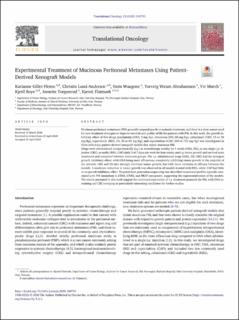| dc.contributor.author | Fleten, Karianne Giller | |
| dc.contributor.author | Lund-Andersen, Christin | |
| dc.contributor.author | Waagene, Stein | |
| dc.contributor.author | Abrahamsen, Torveig Weum | |
| dc.contributor.author | Mørch, Yrr | |
| dc.contributor.author | Pedersen, Kjetil Boye | |
| dc.contributor.author | Kristensen, Annette Torgunrud | |
| dc.contributor.author | Flatmark, Kjersti | |
| dc.date.accessioned | 2021-01-08T13:09:30Z | |
| dc.date.available | 2021-01-08T13:09:30Z | |
| dc.date.created | 2020-11-29T16:27:53Z | |
| dc.date.issued | 2020 | |
| dc.identifier.citation | Translational Oncology. 2020, 13 (8), . | en_US |
| dc.identifier.issn | 1944-7124 | |
| dc.identifier.uri | https://hdl.handle.net/11250/2722215 | |
| dc.description.abstract | Mucinous peritoneal metastases (PM) generally respond poorly to systemic treatment, and there is a clear unmet need for new treatment strategies to improve survival and quality of life for patients with PM. In this work, the growth inhibitory effect of five drugs (oxaliplatin (OXA; 5 mg/kg), irinotecan (IRI; 60 mg/kg), cabazitaxel (CBZ; 15 or 30 mg/kg), regorafenib (REG; 10, 30 or 60 mg/kg), and capecitabine (CAP; 359 or 755 mg/kg) was investigated in three orthotopic patient-derived xenograft models that mimic mucinous PM.
Drugs were administered intraperitoneally (i.p.) as monotherapy weekly for 4 weeks (OXA, IRI), as one single i.p. injection (CBZ), or orally (REG, CAP) daily 5 of 7 days per week for four weeks, and i.p. tumor growth and survival were monitored and compared between treatment groups. The i.p. administered drugs (OXA, IRI, CBZ) had the strongest growth inhibitory effect, with OXA being most efficacious, completely inhibiting tumor growth in the majority of the animals. CBZ and IRI also strongly inhibited tumor growth, but with more variation in efficacy between the models. A moderate reduction in tumor growth was observed in all models treated with REG, while CAP had little to no growth inhibitory effect. Targeted next-generation-sequencing has identified mutational profiles typically associated with PM (mutations in KRAS, GNAS, and BRAF oncogenes), supporting the representativeness of the models. The results presented in this work support the continued exploration of i.p. treatment protocols for PM, with OXA remaining and CBZ emerging as particularly interesting candidates for further studies. | en_US |
| dc.language.iso | eng | en_US |
| dc.publisher | Elsevier | en_US |
| dc.rights | Navngivelse 4.0 Internasjonal | * |
| dc.rights.uri | http://creativecommons.org/licenses/by/4.0/deed.no | * |
| dc.subject | Mucinous peritoneal metastases (PM) | en_US |
| dc.subject | Drugs | en_US |
| dc.title | Experimental Treatment of Mucinous Peritoneal Metastases Using Patient-Derived Xenograft Models | en_US |
| dc.type | Peer reviewed | en_US |
| dc.type | Journal article | en_US |
| dc.description.version | publishedVersion | en_US |
| dc.rights.holder | © 2020 The Author. Published by Elsevier Inc. on behalf of Neoplasia Press, Inc. This is an open access article under the CC BY license (http://creativecommons.org/licenses/by/4.0/). | en_US |
| dc.source.pagenumber | 5 | en_US |
| dc.source.volume | 13 | en_US |
| dc.source.journal | Translational Oncology | en_US |
| dc.source.issue | 8 | en_US |
| dc.identifier.doi | 10.1016/j.tranon.2020.100793 | |
| dc.identifier.cristin | 1853795 | |
| dc.source.articlenumber | 100793 | en_US |
| cristin.ispublished | true | |
| cristin.fulltext | original | |
| cristin.qualitycode | 1 | |

